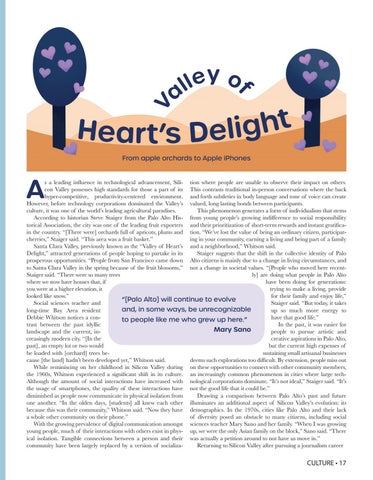ll ey of a
V
t h g Heart’s Deli From apple orchards to Apple iPhones
A
s a leading influence in technological advancement, Sili- tion where people are unable to observe their impact on others. con Valley possesses high standards for those a part of its This contrasts traditional in-person conversations where the back hyper-competitive, productivity-centered environment. and forth subtleties in body language and tone of voice can create However, before technology corporations dominated the Valley’s valued, long lasting bonds between participants. culture, it was one of the world’s leading agricultural paradises. This phenomenon generates a form of individualism that stems According to historian Steve Staiger from the Palo Alto His- from young people’s growing indifference to social responsibility torical Association, the city was one of the leading fruit exporters and their prioritization of short-term rewards and instant gratificain the country. “[There were] orchards full of apricots, plums and tion. “We’ve lost the value of being an ordinary citizen, participatcherries,” Staiger said. “This area was a fruit basket.” ing in your community, earning a living and being part of a family Santa Clara Valley, previously known as the “Valley of Heart’s and a neighborhood,” Whitson said. Delight,” attracted generations of people hoping to partake in its Staiger suggests that the shift in the collective identity of Palo prosperous opportunities. “People from San Francisco came down Alto citizens is mainly due to a change in living circumstances, and to Santa Clara Valley in the spring because of the fruit blossoms,” not a change in societal values. “[People who moved here recentStaiger said. “There were so many trees ly] are doing what people in Palo Alto where we now have houses that, if have been doing for generations: you were at a higher elevation, it trying to make a living, provide looked like snow.” for their family and enjoy life,” “[Palo Alto] will continue to evolve Social sciences teacher and Staiger said. “But today, it takes and, in some ways, be unrecognizable long-time Bay Area resident up so much more energy to Debbie Whitson notices a conhave that good life.” to people like me who grew up here.” trast between the past idyllic In the past, it was easier for Mary Sano landscape and the current, inpeople to pursue artistic and creasingly modern city. “[In the creative aspirations in Palo Alto, past], an empty lot or two would but the current high expenses of be loaded with [orchard] trees besustaining small artisanal businesses cause [the land] hadn’t been developed yet,” Whitson said. deems such explorations too difficult. By extension, people miss out While reminiscing on her childhood in Silicon Valley during on these opportunities to connect with other community members, the 1960s, Whitson experienced a significant shift in its culture. an increasingly common phenomenon in cities where large techAlthough the amount of social interactions have increased with nological corporations dominate. “It’s not ideal,” Staiger said. “It’s the usage of smartphones, the quality of these interactions have not the good life that it could be.” diminished as people now communicate in physical isolation from Drawing a comparison between Palo Alto’s past and future one another. “In the olden days, [students] all knew each other illuminates an additional aspect of Silicon Valley’s evolution: its because this was their community,” Whitson said. “Now they have demographics. In the 1970s, cities like Palo Alto and their lack a whole other community on their phone.” of diversity posed an obstacle to many citizens, including social With the growing prevalence of digital communication amongst sciences teacher Mary Sano and her family. “When I was growing young people, much of their interactions with others exist in phys- up, we were the only Asian family on the block,” Sano said. “There ical isolation. Tangible connections between a person and their was actually a petition around to not have us move in.” community have been largely replaced by a version of socializaReturning to Silicon Valley after pursuing a journalism career
CULTURE • 17











